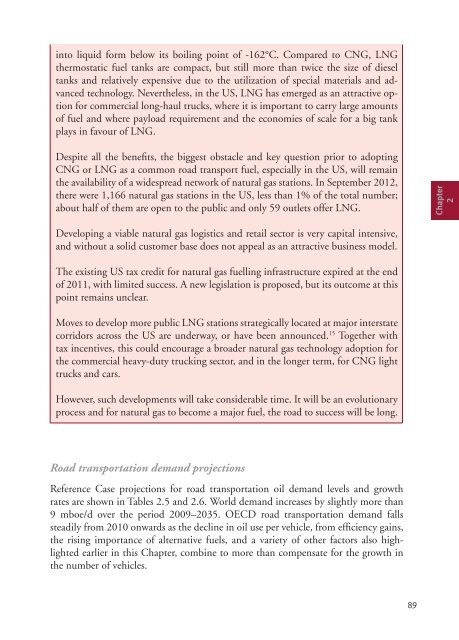World Oil Outlook - Opec
World Oil Outlook - Opec
World Oil Outlook - Opec
- TAGS
- world
- outlook
- opec
- www.opec.org
You also want an ePaper? Increase the reach of your titles
YUMPU automatically turns print PDFs into web optimized ePapers that Google loves.
into liquid form below its boiling point of -162°C. Compared to CNG, LNG<br />
thermostatic fuel tanks are compact, but still more than twice the size of diesel<br />
tanks and relatively expensive due to the utilization of special materials and advanced<br />
technology. Nevertheless, in the US, LNG has emerged as an attractive option<br />
for commercial long-haul trucks, where it is important to carry large amounts<br />
of fuel and where payload requirement and the economies of scale for a big tank<br />
plays in favour of LNG.<br />
Despite all the benefits, the biggest obstacle and key question prior to adopting<br />
CNG or LNG as a common road transport fuel, especially in the US, will remain<br />
the availability of a widespread network of natural gas stations. In September 2012,<br />
there were 1,166 natural gas stations in the US, less than 1% of the total number;<br />
about half of them are open to the public and only 59 outlets offer LNG.<br />
Developing a viable natural gas logistics and retail sector is very capital intensive,<br />
and without a solid customer base does not appeal as an attractive business model.<br />
The existing US tax credit for natural gas fuelling infrastructure expired at the end<br />
of 2011, with limited success. A new legislation is proposed, but its outcome at this<br />
point remains unclear.<br />
Moves to develop more public LNG stations strategically located at major interstate<br />
corridors across the US are underway, or have been announced. 15 Together with<br />
tax incentives, this could encourage a broader natural gas technology adoption for<br />
the commercial heavy-duty trucking sector, and in the longer term, for CNG light<br />
trucks and cars.<br />
However, such developments will take considerable time. It will be an evolutionary<br />
process and for natural gas to become a major fuel, the road to success will be long.<br />
Road transportation demand projections<br />
Reference Case projections for road transportation oil demand levels and growth<br />
rates are shown in Tables 2.5 and 2.6. <strong>World</strong> demand increases by slightly more than<br />
9 mboe/d over the period 2009–2035. OECD road transportation demand falls<br />
steadily from 2010 onwards as the decline in oil use per vehicle, from efficiency gains,<br />
the rising importance of alternative fuels, and a variety of other factors also highlighted<br />
earlier in this Chapter, combine to more than compensate for the growth in<br />
the number of vehicles.<br />
89<br />
Chapter<br />
2
















